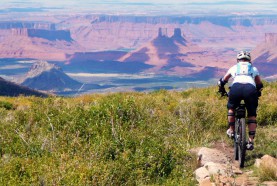Zion National Park is a rare refuge that’s beauty can’t be fully captured in either words or pictures, but here goes
Visiting Zion is a life-altering experience. Utah’s oldest national park, the immensity of its canyons, views and hikes is awe-inspiring stuff. It’s no wonder, then, that Zion attracts some 3 million visitors annually.
During peak season a multi-passenger, open-air shuttle system is the only motorised transport permitted in Zion’s main canyon. Via shuttle, visitors can take in famed formations the Great White Throne, Angels Landing, and Weeping Rock.
Zion self-guided trails are similarly easy to navigate; Gateway to the Narrows is even suitable for strollers and wheelchairs with assistance.
Fancy tackling a puff-inducing, adventurous hike? The Subway, Angels Landing and The Narrows are all guaranteed to fit the bill.
Hiking
When seasoned outdoor adventurers think of Utah’s Zion National Park, hiking’s likely to be the first activity to mind.
With something to offer all ages and experience levels, and year-round accessibility, there’s no chance of boredom or idleness.
Several lower trails offer wheelchair accessibility, while many trailheads are featured on the park’s shuttle route.
The Narrows– Zion Park’s most popular hike takes in the Narrows along Virgin River. Mile one makes for an easygoing walk; it’s paved and picturesque, including streamlets and hanging gardens. If you’re a casual hiker with more energy to expend, carry on up the river. Or, for hardcore hikers, walk the canyon’s whole 16 miles. You’ll need a permit for this, but not to hike into the bottom of the Narrows.
Angels Landing- Zion National Park’s Angels Landing is one of the United States’ most famous and rewarding hikes. Running along a narrow ridge, the well-maintained trail featuring heart-pounding chasms on either side, then culminates in a lofty perch with stunning 360 views. Intimidating? Yes. But don’t let that stop you, as this mammoth monolith is one of the Southwest’s most impressive natural landmarks.
Orderville Gulch – An alternative to tackling the whole of the Narrows. Orderville Gulch is arguably even more beautiful. What’s more, permits for the technical hike – some 11 miles long – are easier to obtain.
Kolob Canyons– Access the trailhead of Zion National Park’s Kolob Canyons via I-15, 18 miles south of Cedar City. It’s a 14-mile round trip that’s flanked by other trails.
Canyoneering
Canyoneering – the sport of hiking, rappelling and swimming through obstacle-filled canyons – finds rich pickings in Utah’s Zion National Park. Some of the world’s most popular canyoneering routes call the area home including:
The Subway – In a park renowned for its beauty the Subway still brings something special to the table. It features a taxing 9.5 mile hike with short rappels or down climbs, and swims through deep pools of super-chilly water. The route typically starts at Wildcat Canyon Trailhead and finishes at the Left Fork Trailhead.
Orderville Canyon – Another popular canyon. If extensive swimming isn’t your thing, don’t even think of canyoneering Orderville. It also features short rappels.
Mystery Canyon – Lesser-frequented than other Zion canyoning spots due to a cap of 12 hikers/day, Mystery is nonetheless a favourite of technical canyoneers. Before setting off ensure you have two 140’ ropes, harness descending equipment, emergency overnight gear, emergency ascending equipment, and loads of water.
Pine Creek – A technical slot canyon that requires rappels and swimming. Taking, on average, four hours to complete, be sure to pack your 60 metre rope for rappels up to 100 ft.
Horseback Riding
To explore the natural wonders in and around Zion National Park, climb aboard a horse.
Not only will your four-legged friend do all the work for you, you’ll gain access to areas of Utah other tourists don’t get to see.
In the lower sections of Zion, temperatures are pleasant year-round. The area is rich in wildlife, and you’ll have the perfect vantage point from atop your steed. The varied terrain includes alpine forest, canyons and desert.
Whatever your riding know-how, there’s something to suit at Zion.
Mountain Biking
Recognised internationally as a mountain biking hotspot, Southern Utah offers diverse landscape regardless of your level of experience.
Tackle desert single-track trails, Slickrock riding, and even alpine rides – all within beautiful Southern Utah.
Pa’rus Trail – Interconnecting Pa’rus Trail, roughly 3.5 miles long, enables cyclists to traverse lower Zion, ultimately linking to the Canyon Scenic Drive. Shuttle buses operate throughout; secure your ride to a bike rack and hitch to the top of Zion Canyon. From there, point your bike downhill, along the Scenic Drive, finishing once again on the Pa’rus Trail.
Gooseberry Mesa Trail – Seven miles south of Rockville, Gooseberry Mesa Trail is ten glorious miles free of pesky RVs and meandering tourists. The main trail is moderately challenging. Alternatively, test your mettle on a new trail system that includes both technically exacting Slickrock and single track.
The J.E.M. Trail– The J.E.M. trail sits west of Virgin near Zion National Park. Take on the desert at high speed, then hug the cliff side along Virgin River. For the most part a manageable technical ride, there is one hairy switchback that many choose to walk. For a ride just shy of 13 miles, take the classic J.E.M. loop with an elevation gain of 800 feet. Alternatively, incorporate Goulds and Hurricane Rim into the mix for a 21-mile loop.

